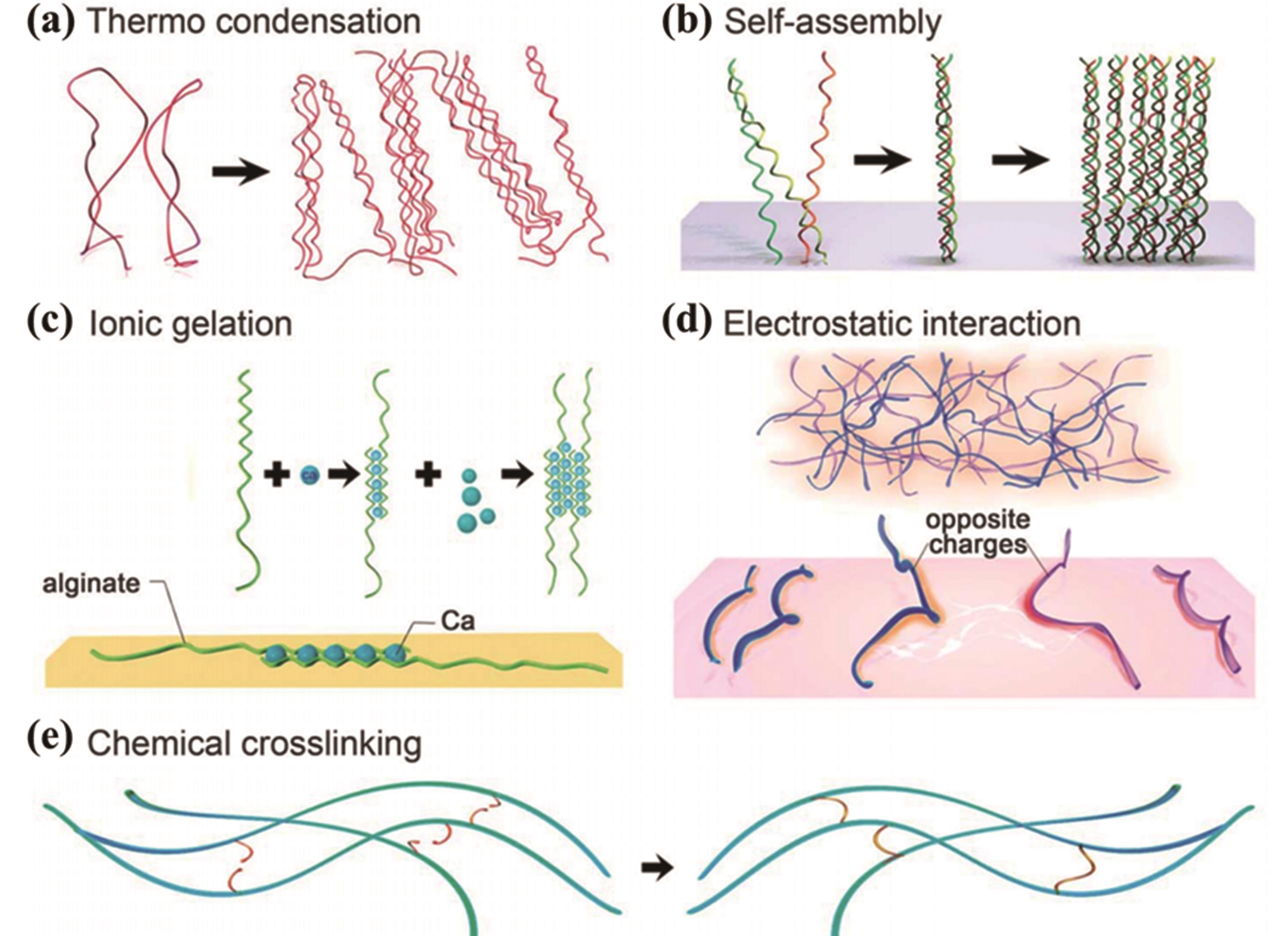
Chinese Journal of Applied Chemistry ›› 2022, Vol. 39 ›› Issue (1): 35-54.DOI: 10.19894/j.issn.1000-0518.210488
• Review • Previous Articles Next Articles
Bio⁃inspired Hydrogels: Synthesis, Bionic Design and Applications in the Field of Energy Storage and Conversion
LIU Xu1,LI Yang-Ke-Xin1,DU Li1,YU Jian2,WANG Jia-Cheng1,GENG Yang1,HAN Guang2,SUN Kuan1,LI Meng1( )
)
- 1.CQU-NUS Renewable Energy Materials & Devices Joint Laboratory,MOE Key Laboratory of Low-Grade Energy Utilization Technologies and Systems,School of Energy & Power Engineering,Chongqing University,Chongqing 400044,China
2.School of Materials Science and Engineering,Chongqing University,Chongqing 400044,China
-
Received:2021-09-30Accepted:2021-11-04Published:2022-01-01Online:2022-01-10 -
Contact:Meng LI -
About author:limeng@cqu.edu.cn
-
Supported by:the National Natural Science Foundation of China(51702032);the Natural Science Foundation of Chongqing(cstc2018jcyjAX0375)
CLC Number:
Cite this article
LIU Xu, LI Yang-Ke-Xin, DU Li, YU Jian, WANG Jia-Cheng, GENG Yang, HAN Guang, SUN Kuan, LI Meng. Bio⁃inspired Hydrogels: Synthesis, Bionic Design and Applications in the Field of Energy Storage and Conversion[J]. Chinese Journal of Applied Chemistry, 2022, 39(1): 35-54.
share this article
Add to citation manager EndNote|Ris|BibTeX
URL: http://yyhx.ciac.jl.cn/EN/10.19894/j.issn.1000-0518.210488
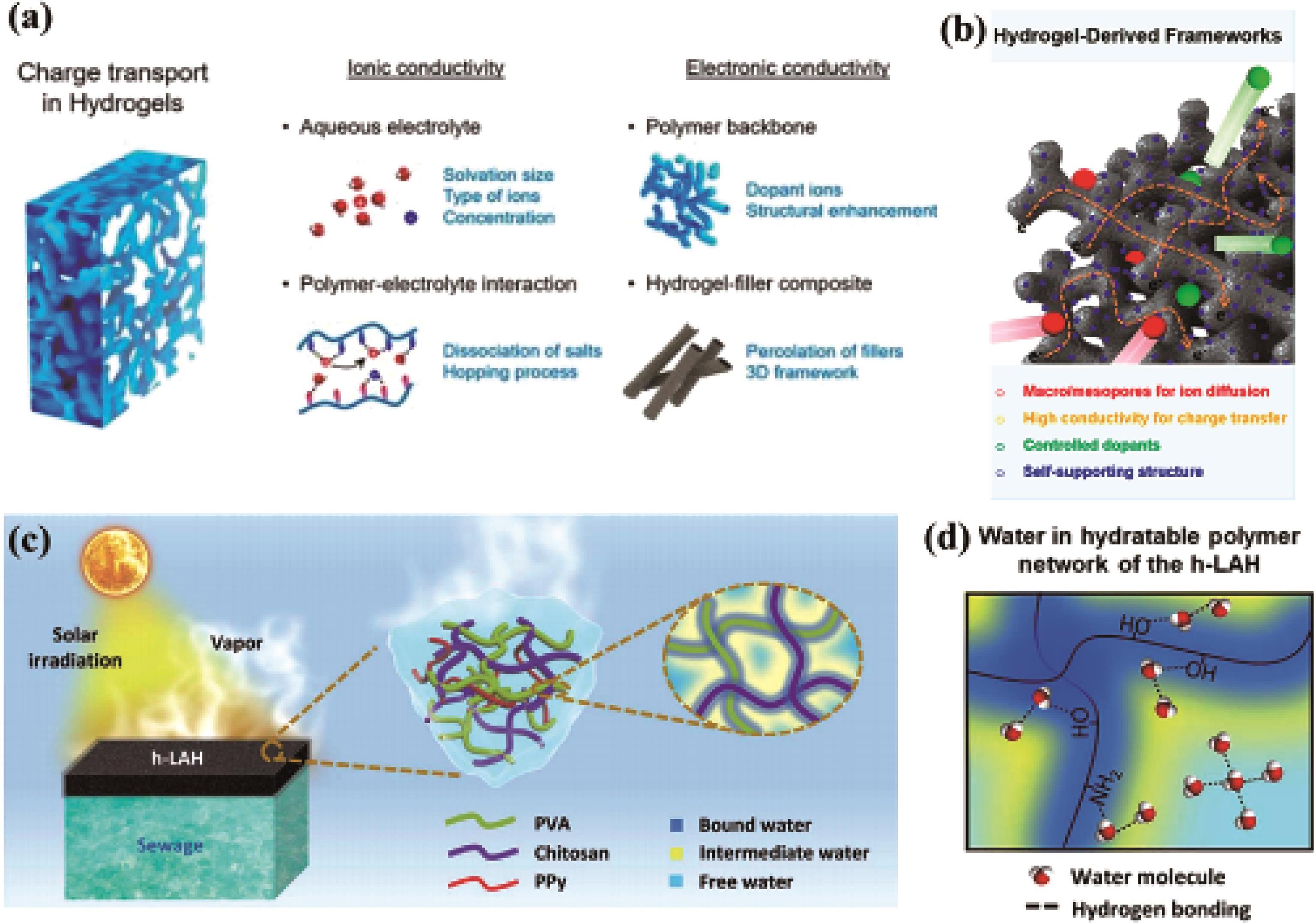
Fig.1 Applications of hydrogels :(a) Conduction mechanism in hydrogels[17]; (b) Characterization of hydrogel-derived framework[17]; (c - d) Tuning water states in the network of hydrogel[25]
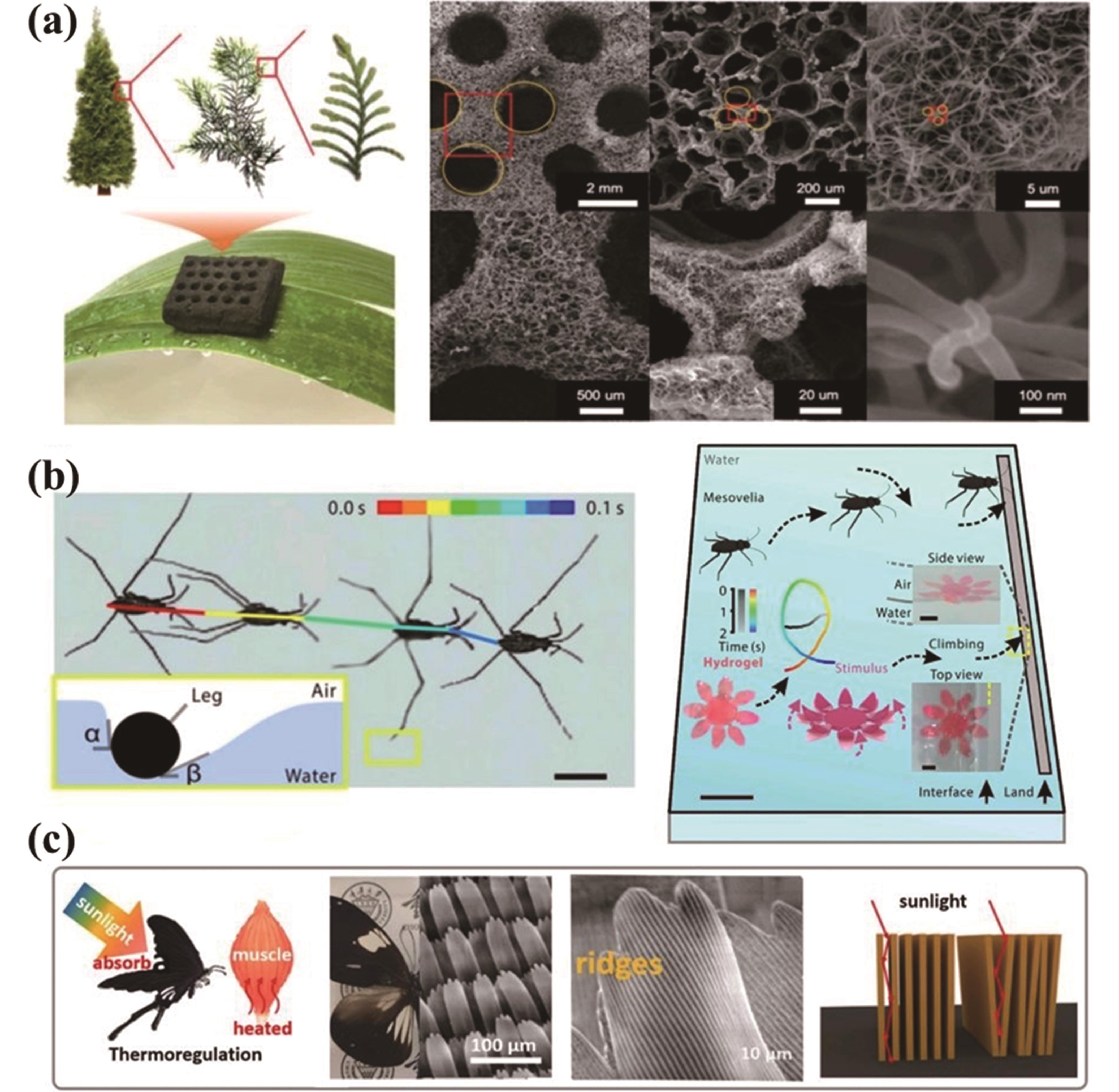
Fig.2 Some bio-inspired work: (a) Enhanced solar evaporation inspired by fractal structure[26]; (b) Self-propelled hydrogel inspired by water striders[28]; (c) Improvement mechanism of light adsorption inspired by butterfly wings[30]
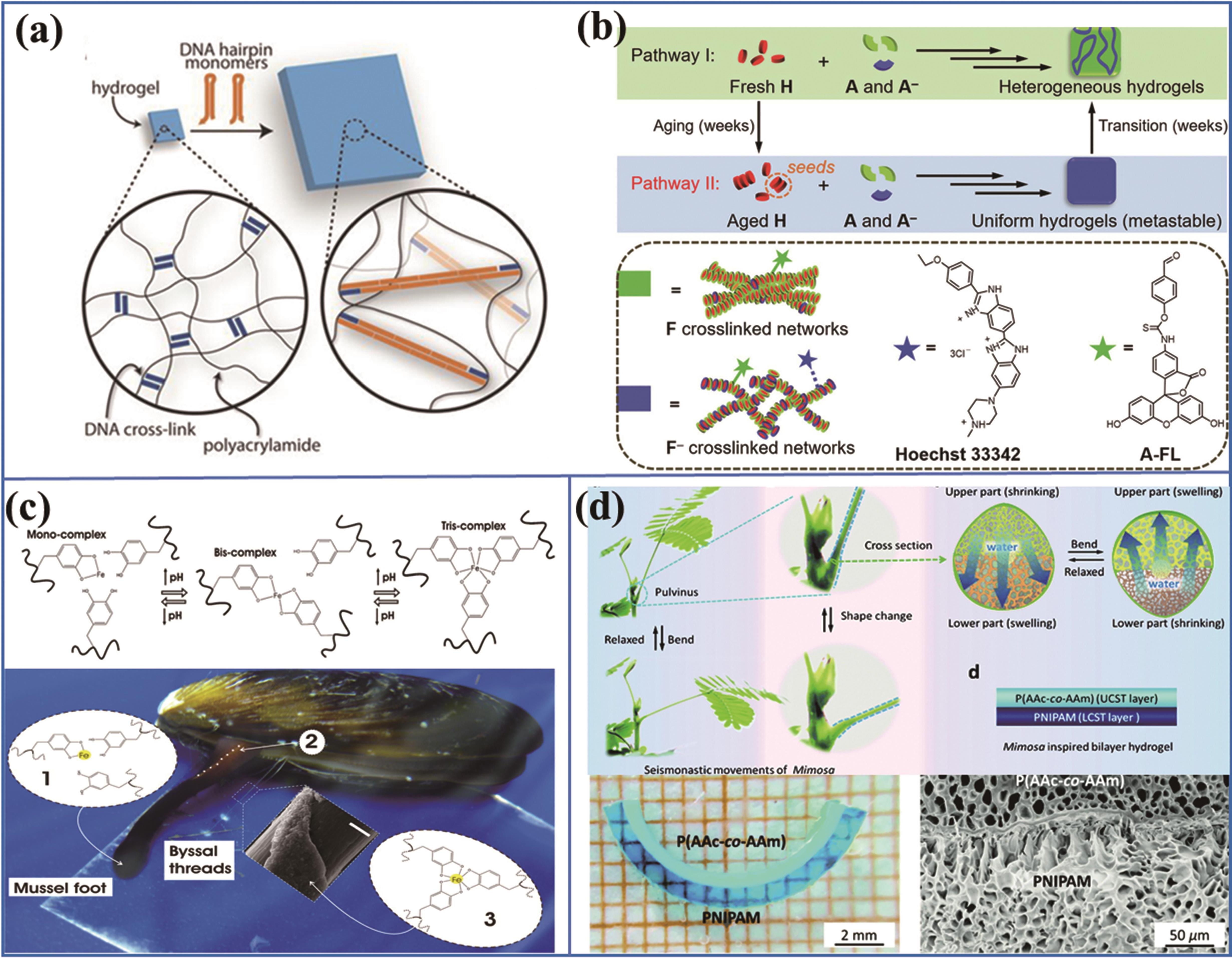
Fig.4 Correlated work of bio-inspired hydrogels: (a) DNA sequence-directed shape change of hydrogels[57]; (b) Self-assembly phenomenon in synthesis of hydrogels[63]; (c) Mussel-inspired functional hydrogel[64]; (d) Mimosa-inspired hydrogel actuator[60]
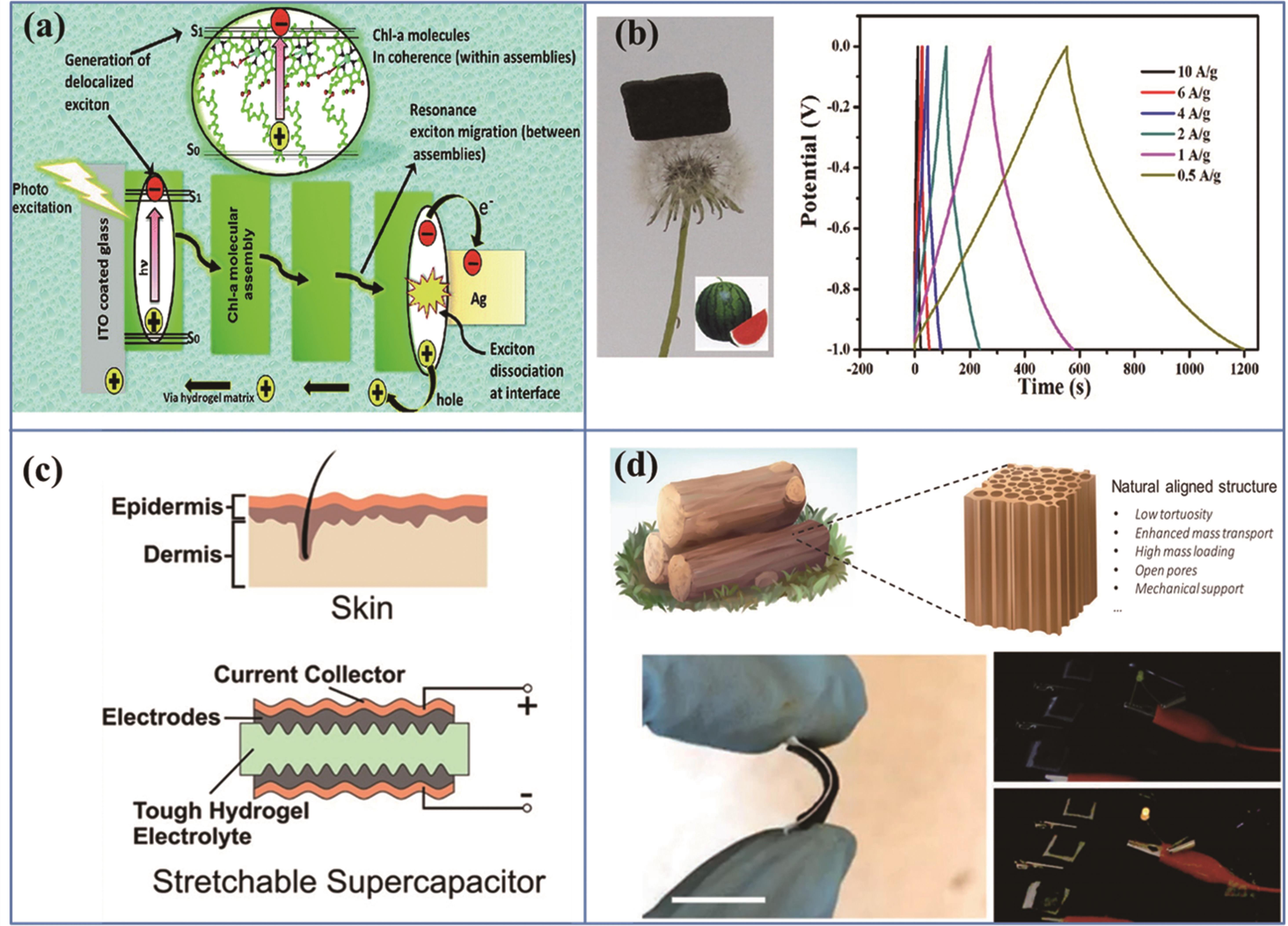
Fig.5 Applications of bio-inspired hydrogels in batteries: (a) A chlorophyll-a/polyacrylamide hydrogel for biomimetic solar cells[80]; (b) Biomass-derived hydrogel for supercapacitors[81]; (c) Skin-inspired tough hydrogel electrolyte[9]; (d) Wood-Inspired Morphologically Tunable Aligned Hydrogel for Supercapacitors[82]

Fig.6 (a - b) H2O2 generation of the bionic sunflower[35]; (c) The photodegradation of seagrass-inspired hydrogel[91];(d - f) The HER performance of the bio-inspired hydrogel[92]
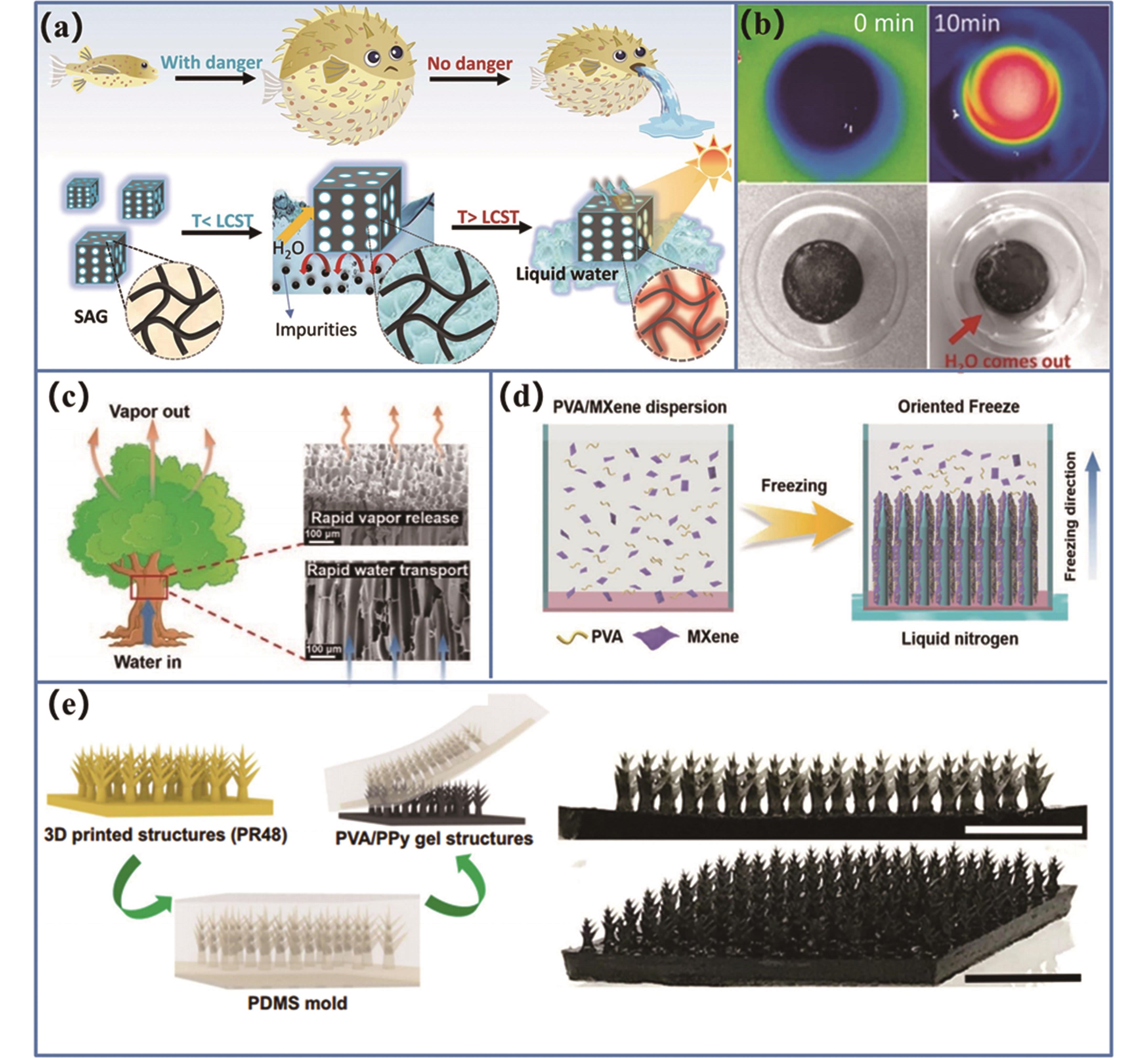
Fig.7 Designs of bio-inspired for water collection and solar evaporation:(a - b)Pufferfish-inspired hydrogels for water purification[99]; (c - d)Tree-inspired hydrogels for solar evaporation [100];(e) The synthesis routine and morphology of the micro-tree hydrogel[101]
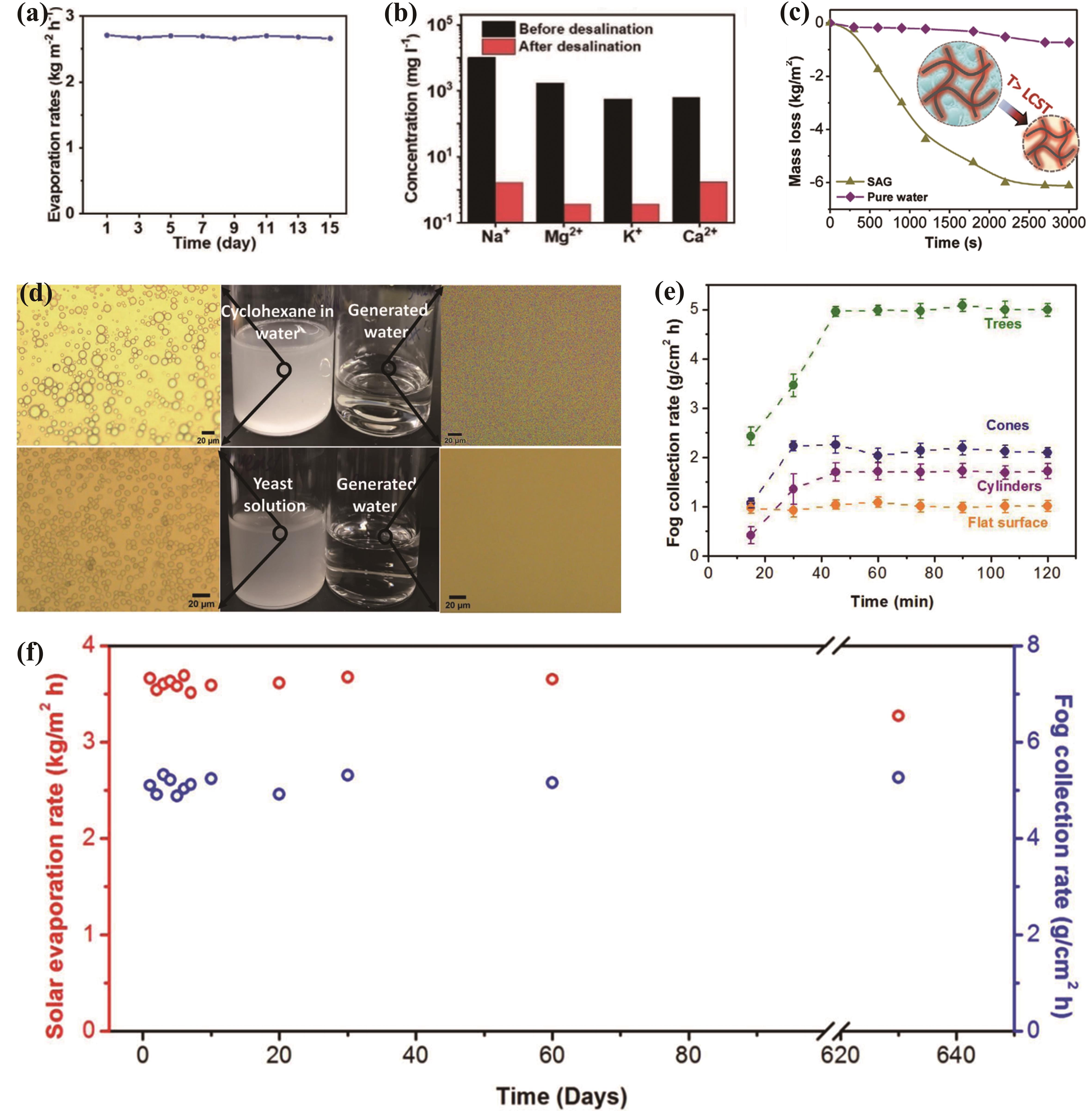
Fig.9 (a,b) The evaporation performance of TIH[100]; (c,d) The purification performance of the pufferfish-inspired hydrogels[99]; (e,f) The water collection performance of the micro-tree hydrogels[101]
| 1 | NI G, LI G, BORISKINA S V, et al. Steam generation under one sun enabled by a floating structure with thermal concentration[J]. Nat Energy, 2016, 1(9):16126. |
| 2 | ZHANG Q, UCHAKER E, CANDELARIA S L, et al. Nanomaterials for energy conversion and storage[J]. Chem Soc Rev, 2013, 42(7): 3127-3171. |
| 3 | DUNN B, KAMATH H, TARASCON J M. Electrical energy storage for the grid: a battery of choices[J]. Science, 2011, 334(6058): 928-935. |
| 4 | DING Y, ZHANG C, ZHANG L, et al. Molecular engineering of organic electroactive materials for redox flow batteries[J]. Chem Soc Rev, 2018, 47(1): 69-103. |
| 5 | DING Y, LI Y, YU G. Exploring bio-inspired Quinone-based organic redox flow batteries: a combined experimental and computational study[J]. Chem, 2016, 1(5): 790-801. |
| 6 | ZHANG L, ZHANG C, DING Y, et al. A low-cost and high-energy hybrid iron-aluminum liquid battery achieved by deep eutectic solvents[J]. Joule, 2017, 1(3): 623-633. |
| 7 | ZHAO Y, DING Y, LI Y, et al. A chemistry and material perspective on lithium redox flow batteries towards high-density electrical energy storage[J]. Chem Soc Rev, 2015, 44(22): 7968-7996. |
| 8 | DING Y, ZHAO Y, LI Y, et al. A high-performance all-metallocene-based, non-aqueous redox flow battery[J]. Energy Environ Sci, 2017, 10(2): 491-497. |
| 9 | FANG L, CAI Z, DING Z, et al. Skin-inspired surface-microstructured tough hydrogel electrolytes for stretchable supercapacitors[J]. ACS Appl Mater Interfaces, 2019, 11(24): 21895-21903. |
| 10 | ZHANG J, QU L, SHI G, et al. N,P-codoped carbon networks as efficient metal-free bifunctional catalysts for oxygen reduction and hydrogen evolution reactions[J]. Angew Chem Int Ed Engl, 2016, 55(6): 2230-2234. |
| 11 | ZHAO F, BAE J, ZHOU X, et al. Nanostructured functional hydrogels as an emerging platform for advanced energy technologies[J]. Adv Mater, 2018, 30(48): e1801796. |
| 12 | GUO Y, BAE J, ZHAO F, et al. Functional hydrogels for next-generation batteries and supercapacitors[J]. Trends Chem, 2019, 1(3): 335-348. |
| 13 | TAO P, NI G, SONG C, et al. Solar-driven interfacial evaporation[J]. Nat Energy, 2018, 3(12): 1031-1041. |
| 14 | GENG Y, ZHANG K, YANG K, et al. Constructing hierarchical carbon framework and quantifying water transfer for novel solar evaporation configuration[J]. Carbon, 2019, 155: 25-33. |
| 15 | GUO Y, YU G. Engineering hydrogels for efficient solar desalination and water purification[J]. Acc Mater Res, 2021, 2(5): 374-384. |
| 16 | ZENG X, QIAN L, YUAN X, et al. Inspired by stenocara beetles: from water collection to high-efficiency water-in-oil emulsion separation[J]. ACS Nano, 2017, 11(1): 760-769. |
| 17 | GUO Y, BAE J, FANG Z, et al. Hydrogels and hydrogel-derived materials for energy and water sustainability[J]. Chem Rev, 2020, 120(15): 7642-7707. |
| 18 | PEERS S, MONTEMBAULT A, LADAVIÈRE C. Chitosan hydrogels for sustained drug delivery[J]. J Control Release, 2020, 326: 150-63. |
| 19 | LI J, MOONEY D J. Designing hydrogels for controlled drug delivery[J]. Nat Rev Mater, 2016, 1(12): 16071. |
| 20 | ZAGÓRSKA-DZIOK M, SOBCZAK M. Hydrogel-based active substance release systems for cosmetology and dermatology application: a review[J]. Pharmaceutics, 2020, 12(5):396. |
| 21 | CHENG L, JI K, SHIH T Y, et al. Injectable shape-memorizing three-dimensional hyaluronic acid cryogels for skin sculpting and soft tissue reconstruction[J]. Tissue Eng Part A, 2016, 23(5/6): 243-251. |
| 22 | VIVERO-LOPEZ M, MURAS A, SILVA D, et al. Resveratrol-loaded hydrogel contact lenses with antioxidant and antibiofilm performance[J]. Pharmaceutics, 2021, 13(4). |
| 23 | YANG C, YIN J, CHEN Z, et al. Highly conductive, stretchable, adhesive, and self-healing polymer hydrogels for strain and pressure sensor[J]. Macromol Mater Eng, 2020, 305(12): 2000479. |
| 24 | SHI Y, ZHANG J, BRUCK A M, et al. A tunable 3D nanostructured conductive gel framework electrode for high-performance lithium ion batteries[J]. Adv Mater, 2017, 29(22): 1603922. |
| 25 | ZHOU X, ZHAO F, GUO Y, et al. Architecting highly hydratable polymer networks to tune the water state for solar water purification[J]. Sci Adv, 5(6): eaaw5484. |
| 26 | GENG Y, SUN W, YING P, et al. Bioinspired fractal design of waste biomass-derived solar-thermal materials for highly efficient solar evaporation[J]. Adv Funct Mater, 2020, 31(3):2007648. |
| 27 | GAO X, JIANG L. Water-repellent legs of water striders[J]. Nature, 2004, 432(7013): 36. |
| 28 | ZHU H, XU B, WANG Y, et al. Self-powered locomotion of a hydrogel water strider[J]. Sci Robot, 2021, 6(53): eabe7925. |
| 29 | SCHROEDER T B H, GUHA A, LAMOUREUX A, et al. An electric-eel-inspired soft power source from stacked hydrogels[J]. Nature, 2017, 552(7684): 214-218. |
| 30 | YING P, AI B, HU W, et al. A bio-inspired nanocomposite membrane with improved light-trapping and salt-rejecting performance for solar-driven interfacial evaporation applications[J]. Nano Energy, 2021, 89:106443. |
| 31 | LI Y, RODRIGUES J, TOMÁS H. Injectable and biodegradable hydrogels: gelation, biodegradation and biomedical applications[J]. Chem Soc Rev, 2012, 41(6): 2193-2221. |
| 32 | KO D Y, SHINDE U P, YEON B, et al. Recent progress of in situ formed gels for biomedical applications[J]. Prog Polym Sci , 2013, 38(3): 672-701. |
| 33 | WANG C, STEWART R J, KOPEČEK J. Hybrid hydrogels assembled from synthetic polymers and coiled-coil protein domains[J]. Nature, 1999, 397(6718): 417-420. |
| 34 | GUO B, HOSHINO Y, GAO F, et al. Thermocells driven by phase transition of hydrogel nanoparticles[J]. J Am Chem Soc , 2020, 142(41): 17318-17322. |
| 35 | QIN J, CHU K, HUANG Y, et al. The bionic sunflower: a bio-inspired autonomous light tracking photocatalytic system[J]. Energ Environ Sci , 2021, 14(7): 3931-3937. |
| 36 | JIANG B, LIU X, YANG C, et al. Injectable, photoresponsive hydrogels for delivering neuroprotective proteins enabled by metal-directed protein assembly[J]. Sci Adv, 6(41): eabc4824. |
| 37 | LIU T, WANG F, WU Q, et al. Fluorescent, electrically responsive and ultratough self-healing hydrogels via bioinspired all-in-one hierarchical micelles[J]. Mater Horiz, 2021, 8:3096. |
| 38 | PARDO A, GÓMEZ-FLORIT M, BARBOSA S, et al. Magnetic nanocomposite hydrogels for tissue engineering: design concepts and remote actuation strategies to control cell fate[J]. ACS Nano, 2021, 15(1): 175-209. |
| 39 | ZHANG Y, WU F, LI M, et al. pH switching on-off semi-IPN hydrogel based on cross-linked poly(acrylamide-co-acrylic acid) and linear polyallyamine[J]. Polymer, 2005, 46(18): 7695-7700. |
| 40 | GUO W, LU C H, ORBACH R, et al. pH-stimulated DNA hydrogels exhibiting shape-memory properties[J]. Adv Mater, 2015, 27(1): 73-78. |
| 41 | GALPERIN A, LONG T J, RATNER B D. Degradable, thermo-sensitive poly(N-isopropyl acrylamide)-based scaffolds with controlled porosity for tissue engineering applications[J]. Biomacromolecules, 2010, 11(10): 2583-2592. |
| 42 | OKANO T, BAE Y H, JACOBS H, et al. Thermally on-off witching polymers for drug permeation and release[J]. J Control Release, 1990, 11: 255-265. |
| 43 | DUAN J, YU B, LIU K, et al. P-N conversion in thermogalvanic cells induced by thermo-sensitive nanogels for body heat harvesting[J]. Nano Energy, 2019, 57: 473-479. |
| 44 | YOKOYAMA F, ACHIFE E, MOMODA J, et al. Morphology of optically anisotropic agarose hydrogel prepared by directional freezing[J]. Colloid Polym Sci, 1990, 268: 552-558. |
| 45 | GONG J P. Why are double network hydrogels so tough?[J]. Soft Matter, 2010, 6(12): 2583-2590. |
| 46 | GONG J P, KATSUYAMA Y, KUROKAWA T, et al. Double-network hydrogels with extremely high mechanical strength[J]. Adv Mater, 2003, 15(14): 1155-1158. |
| 47 | MACAN J. Definitions of terms relating to the structure and processing of sols, gels, networks, and inorganic-organic hybrid materials[J]. Kemija U Industriji, 2011, 60(3): 135-153. |
| 48 | ZHANG Y S, KHADEMHOSSEINI A. Advances in engineering hydrogels[J]. Science, 2017, 356(6337):eaaf3627. |
| 49 | AHMED E M. Hydrogel: preparation, characterization, and applications: a review[J]. J Adv Res, 2015, 6(2): 105-121. |
| 50 | SILVERSTEIN T. The real reason why oil and water don't mix[J]. J Chem Educ, 1998, 75(1):116. |
| 51 | HASELMEIER R, HOLZ M, MARBACH W, et al. Water dynamics near a dissolved noble gas. first direct experimental evidence for a retardation effect[J]. J Phys Chem, 1995, 99(8): 2243-2246. |
| 52 | GACESA P. Alginates[J]. Carbonhydr Polym, 1988, 8(3): 161-182. |
| 53 | NELE V, WOJCIECHOWSKI J P, ARMSTRONG J P K, et al. Tailoring gelation mechanisms for advanced hydrogel applications[J]. Adv Funct Mater, 2020, 30(42): 2002759. |
| 54 | HENNINK W E, VAN NOSTRUM C F. Novel crosslinking methods to design hydrogels[J]. Adv Drug Deliver Rev, 2012, 64(1): 223-236. |
| 55 | VARAPRASAD K, RAGHAVENDRA G M, JAYARAMUDU T, et al. A mini review on hydrogels classification and recent developments in miscellaneous applications[J]. Mater Sci Eng C, 2017, 79: 958-971. |
| 56 | GAO H, ZHOU W, JANG J H, et al. Cross-linked chitosan as a polymer network binder for an antimony anode in sodium-ion batteries[J]. Adv Energy Mater, 2016, 6(6): 1502130. |
| 57 | CANGIALOSI A, YOON C, LIU J, et al. DNA sequence-directed shape change of photopatterned hydrogels via high-degree swelling[J]. Science, 2017, 357(6356): 1126-1130. |
| 58 | FAN H, GONG J P. Fabrication of bioinspired hydrogels: challenges and opportunities[J]. Macromolecules, 2020, 53(8): 2769-2782. |
| 59 | WANG J, LIN L, CHENG Q, et al. A strong bio-inspired layered PNIPAM-clay nanocomposite hydrogel[J]. Angew Chem Int Ed, 2012, 51(19): 4676-4680. |
| 60 | ZHENG J, XIAO P, LE X, et al. Mimosa inspired bilayer hydrogel actuator functioning in multi-environments[J]. J Mater Chem C, 2018, 6(6): 1320-1327. |
| 61 | WANG Y, DE KRUIJFF R M, LOVRAK M, et al. Access to metastable gel states using seeded self-assembly of low-molecular-weight gelators[J]. Angew Chem Int Ed, 2019, 58(12): 3800-3803. |
| 62 | WANG Y, LOVRAK M, LIU Q, et al. Hierarchically compartmentalized supramolecular gels through multilevel self-sorting[J]. J Am Chem Soc, 2019, 141(7): 2847-2851. |
| 63 | WANG Y, PISKORZ T K, LOVRAK M, et al. Transient supramolecular hydrogels formed by aging-induced seeded self-assembly of molecular hydrogelators[J]. Adv Sci, 2020, 7(7): 1902487. |
| 64 | HOLTEN-ANDERSEN N, HARRINGTON M J, BIRKEDAL H, et al. pH-induced metal-ligand cross-links inspired by mussel yield self-healing polymer networks with near-covalent elastic moduli[J]. Proc Natl Acad Sci USA, 2011, 108(7): 2651-2655. |
| 65 | SHI Y, PENG L, YU G. Nanostructured conducting polymer hydrogels for energy storage applications[J]. Nanoscale, 2015, 7(30): 12796-12806. |
| 66 | YANO H, KUDO K, MARUMO K, et al. Fully soluble self-doped poly(3,4-ethylenedioxythiophene) with an electrical conductivity greater than 1000 S cm-1[J]. Sci Adv, 2019,5(4): eaav9492. |
| 67 | FORD H O, PARK B, JIANG J, et al. Enhanced Li+ conduction within single-ion conducting polymer gel electrolytes via reduced cation-polymer interaction[J]. ACS Mater Lett, 2020, 2(3): 272-279. |
| 68 | CACCAVO D, CASCONE S, LAMBERTI G, et al. Hydrogels: experimental characterization and mathematical modelling of their mechanical and diffusive behaviour[J]. Chem Soc Rev, 2018, 47(7): 2357-2373. |
| 69 | CHOI D, WANG D, BAE I T, et al. LiMnPO4 nanoplate grown via solid-state reaction in molten hydrocarbon for Li-ion battery cathode[J]. Nano Lett, 2010, 10(8): 2799-2805. |
| 70 | ZHAO F, SHI Y, PAN L, et al. Multifunctional nanostructured conductive polymer gels: synthesis, properties, and applications[J]. Acc Chem Res, 2017, 50(7): 1734-1743. |
| 71 | HASEGAWA G, ISHIHARA Y, KANAMORI K, et al. Facile preparation of monolithic LiFePO4/carbon composites with well-defined macropores for a lithium-ion battery[J]. Chem Mater, 2011, 23. |
| 72 | ZHANG P, WANG K, PEI P, et al. Selection of hydrogel electrolytes for flexible zinc-air batteries[J]. Mater Today Chem, 2021, 21: 100538. |
| 73 | ZHAO S, ZUO Y, LIU T, et al. Multi-functional hydrogels for flexible zinc-based batteries working under extreme conditions[J]. Adv Energy Mater, 2021, 11(34): 2101749. |
| 74 | LIZUNDIA E, KUNDU D. Advances in natural biopolymer-based electrolytes and separators for battery applications[J]. Adv Funct Mater, 2021, 31(3): 2005646. |
| 75 | ALLAN P K, GRIFFIN J M, DARWICHE A, et al. Tracking sodium-antimonide phase transformations in sodium-ion anodes: insights from operando pair distribution function analysis and solid-state NMR spectroscopy[J]. J Am Chem Soc, 2016, 138(7): 2352-2365. |
| 76 | WU P, ZHANG A, PENG L, et al. Cyanogel-enabled homogeneous Sb-Ni-C ternary framework electrodes for enhanced sodium storage[J]. ACS Nano, 2018, 12(1): 759-767. |
| 77 | QIN G, WANG M, FAN L, et al. Multifunctional supramolecular gel polymer electrolyte for self-healable and cold-resistant supercapacitor[J]. J Power Sources, 2020, 474: 228602. |
| 78 | KOO B, KIM H, CHO Y, et al. A highly cross-linked polymeric binder for high-performance silicon negative electrodes in lithium ion batteries[J]. Angew Chem Int Ed, 2012, 51(35): 8762-8767. |
| 79 | LIU J, ZHANG Q, WU Z Y, et al. A high-performance alginate hydrogel binder for the Si/C anode of a Li-ion battery[J]. Chem Commun, 2014, 50(48): 6386-6389. |
| 80 | MANDAL P, MANNA J S, DAS D, et al. Energy transfer cascade in bio-inspired chlorophyll-a/polyacrylamide hydrogel: towards a new class of biomimetic solar cells[J]. RSC Adv, 2016, 6(93): 90280-90289. |
| 81 | WU X L, WEN T, GUO H L, et al. Biomass-derived sponge-like carbonaceous hydrogels and aerogels for supercapacitors[J]. ACS Nano, 2013, 7(4): 3589-3597. |
| 82 | ZHAO Y, ALSAID Y, YAO B, et al. Wood-Inspired morphologically tunable aligned hydrogel for high-performance flexible all-solid-state supercapacitors[J]. Adv Funct Mater, 2020, 30(10): 1909133. |
| 83 | WANG B, LI J, HOU C, et al. Stable hydrogel electrolytes for flexible and submarine-use Zn-ion batteries[J]. ACS Appl Mater Interfaces, 2020, 12(41): 46005-46014. |
| 84 | RYU J, KIM S W, KANG K, et al. Mineralization of self-assembled peptide nanofibers for rechargeable lithium ion batteries[J]. Adv Mater, 2010, 22(48): 5537-5541. |
| 85 | TIAN M, CHEN X, SUN S, et al. A bioinspired high-modulus mineral hydrogel binder for improving the cycling stability of microsized silicon particle-based lithium-ion battery[J]. Nano Res, 2019, 12(5): 1121-1127. |
| 86 | FU G, YAN X, CHEN Y, et al. Boosting bifunctional oxygen electrocatalysis with 3D graphene aerogel-supported Ni/MnO particles[J]. Adv Mater, 2018, 30(5): 1704609. |
| 87 | JIANG H, ZHU Y, FENG Q, et al. Nitrogen and phosphorus dual-doped hierarchical porous carbon foams as efficient metal-free electrocatalysts for oxygen reduction reactions[J]. Chem Eur J, 2014, 20(11): 3106-3112. |
| 88 | HU Q, LI G, LIU X, et al. Superhydrophilic phytic-acid-doped conductive hydrogels as metal-free and binder-free electrocatalysts for efficient water oxidation[J]. Angew Chem Int Ed, 2019, 58(13): 4318-4322. |
| 89 | GUO X, CAO G L, DING F, et al. A bulky and flexible electrocatalyst for efficient hydrogen evolution based on the growth of MoS2 nanoparticles on carbon nanofiber foam[J]. J Mater Chem A, 2015, 3(9): 5041-5046. |
| 90 | MA C, XIE Z, SEO W C, et al. Carbon dot-coupled BiVO4/reduced graphene hydrogel for significant enhancement of photocatalytic activity: antibiotic degradation and CO2 reduction[J]. Appl Surf Sci, 2021, 565: 150564. |
| 91 | YONG Z, YAP L W, FU R, et al. Seagrass-inspired design of soft photocatalytic sheets based on hydrogel-integrated free-standing 2D nanoassemblies of multifunctional nanohexagons[J]. Mater Horiz, 2021, 8(9): 2533-2540. |
| 92 | SHI Y, DAI W, WANG M, et al. Bioinspired construction of ruthenium-decorated nitrogen-doped graphene aerogel as an efficient electrocatalyst for hydrogen evolution reaction[J]. Chem Res Chinese Univ, 2020, 36(4): 709-714. |
| 93 | WEINGARTEN A S, KAZANTSEV R V, PALMER L C, et al. Self-assembling hydrogel scaffolds for photocatalytic hydrogen production[J]. Nat Chem, 2014, 6(11): 964-970. |
| 94 | YING P, LI M, YU F, et al. Band gap engineering in an efficient solar-driven interfacial evaporation system[J]. ACS Appl Mater Interfaces, 2020, 12(29): 32880-32887. |
| 95 | ZHANG H, WANG Y, LIU Y, et al. Efficient solar evaporation by [Ni(Phen)3][V14O34Cl]Cl hybrid semiconductor confined in mesoporous glass[J]. ChemSusChem, 2020, 13(11): 2945-2951. |
| 96 | CHEN J, YE Z, YANG F, et al. Plasmonic nanostructures for photothermal conversion[J]. Small Sci, 2021, 1(2): 2000055. |
| 97 | SHI Y, MA C, PENG L, et al. Conductive “smart” hybrid hydrogels with PNIPAM and nanostructured conductive polymers[J]. Adv Funct Mater, 2015, 25(8): 1219-1225. |
| 98 | ZHAO F, ZHOU X, SHI Y, et al. Highly efficient solar vapour generation via hierarchically nanostructured gels[J]. Nat Nanotechnol, 2018, 13(6): 489-495. |
| 99 | XU X, OZDEN S, BIZMARK N, et al. A bioinspired elastic hydrogel for solar-driven water purification[J]. Adv Mater, 2021, 33(18): 2007833. |
| 100 | YU Z, WU P. Biomimetic MXene-polyvinyl alcohol composite hydrogel with vertically aligned channels for highly efficient solar steam generation[J]. Adv Mater Technol, 2020, 5(6): 2000065. |
| 101 | SHI Y, ILIC O, ATWATER H A, et al. All-day fresh water harvesting by microstructured hydrogel membranes[J]. Nat Commun, 2021, 12(1): 2797. |
| 102 | LU Y, FAN D, WANG Y, et al. Surface patterning of two-dimensional nanostructure-embedded photothermal hydrogels for high-yield solar steam generation[J]. ACS Nano, 2021, 15(6): 10366-10376. |
| 103 | SEKINE Y, IKEDA-FUKAZAWA T. Structural changes of water in a hydrogel during dehydration[J]. J Chem Phys, 2009, 130(3): 034501. |
| 104 | KUDO K, ISHIDA J, SYUU G, et al. Structural changes of water in poly(vinyl alcohol) hydrogel during dehydration[J]. J Chem Phys, 2014, 140(4): 044909. |
| 105 | ZHAO F, GUO Y, ZHOU X, et al. Materials for solar-powered water evaporation[J]. Nat Rev Mater, 2020, 5(5): 388-401. |
| 106 | GUO Y, ZHOU X, ZHAO F, et al. Synergistic energy nanoconfinement and water activation in hydrogels for efficient solar water desalination[J]. ACS Nano, 2019, 13(7): 7913-7919. |
| 107 | ZHAO F, ZHOU X, LIU Y, et al. Super moisture-absorbent gels for all-weather atmospheric water harvesting[J]. Adv Mater, 2019, 31(10): 1806446. |
| 108 | LI R, SHI Y, ALSAEDI M, et al. Hybrid hydrogel with high water vapor harvesting capacity for deployable solar-driven atmospheric water generator[J]. Environ Sci Technol 2018, 52(19): 11367-11377. |
| 109 | NANDAKUMAR D K, ZHANG Y, RAVI S K, et al. Solar energy triggered clean water harvesting from humid air existing above sea surface enabled by a hydrogel with ultrahigh hygroscopicity[J]. Adv Mater, 2019, 31(10): 1806730. |
| 110 | ENTEZARI A, EJEIAN M, WANG R. Super atmospheric water harvesting hydrogel with alginate chains modified with binary salts[J]. ACS Mater Lett, 2020, 2(5): 471-477. |
| 111 | KALLENBERGER P A, FRÖBA M. Water harvesting from air with a hygroscopic salt in a hydrogel-derived matrix[J]. Commun Chem, 2018, 1(1): 28. |
| 112 | WANG M, SUN T, WAN D, et al. Solar-powered nanostructured biopolymer hygroscopic aerogels for atmospheric water harvesting[J]. Nano Energy, 2021, 80: 105569. |
| 113 | CHEN X, WU Z, LAI D, et al. Resilient biomass-derived hydrogel with tailored topography for highly efficient and long-term solar evaporation of high-salinity brine[J]. J Mater Chem A, 2020, 8(43): 22645-22656. |
| [1] | Xu-Juan HUANG, Ting WANG, Zheng-Qing DING, Xin-Xin YANG, Zhao-Sheng CAI, Shi-Bing SHANG. Preparation of Hydrogels Based on Dehydroabietyl Polyoxyethylene Glycidyl Ether Grafted Hydroxyethyl Chitosan and Their Properties [J]. Chinese Journal of Applied Chemistry, 2022, 39(9): 1421-1428. |
| [2] | TANG Li-Zong, ZHANG Lin, DONG Yun-Sheng, QI Chun-Xiao, LIU Xiang-Sheng, WANG Shu-Fang. Research Progress on Responsive Hydrogels and Their Applications in Biomedicines [J]. Chinese Journal of Applied Chemistry, 2021, 38(7): 743-753. |
| [3] | CHEN Kunfeng,XUE Dongfeng. Colloidal State of Active Cation and Its Limit for Electrochemical Energy Storage [J]. Chinese Journal of Applied Chemistry, 2018, 35(9): 1067-1075. |
| [4] | YANG Xian, MIN Lingli, ZHU Yinglin, CAO Liuxuan, XIE Yanbo, HOU Xu. Recent Research Progress on Nanopores and Nanochannels Based Electrokinetical Energy Conversion Systems [J]. Chinese Journal of Applied Chemistry, 2018, 35(6): 613-624. |
| [5] | GAO Lifang,SONG Zhongqian,SUN Zhonghui,LI Fenghua,HAN Dongxue,NIU Li. Application and Development of Novel Two-Dimensional Nanomaterials in Electrochemistry [J]. Chinese Journal of Applied Chemistry, 2018, 35(3): 247-258. |
| [6] | CHEN Peizhen, LIU Ruilai, RAO Ruiye. Synthesis and Characterization of Poly(N-isopropyl acrylamide)-g-cellulose Hydrogels [J]. Chinese Journal of Applied Chemistry, 2016, 33(12): 1389-1395. |
| [7] | LI Pengchong, XU Kun, TAN Ying, WANG Pixin. Synthesis and Characterization of Microgel-Reinforced Polyampholyte Hydrogels [J]. Chinese Journal of Applied Chemistry, 2015, 32(4): 386-391. |
| [8] | GENG Tongmou*, ZHANG Xia. Synthesis and Swelling Properties of Hydrophobically Modified pH Sensitive Hydrogels P(HEMA-NaAA-DiAC16) [J]. Chinese Journal of Applied Chemistry, 2014, 31(02): 140-146. |
| [9] | CHE Guangbo1, YUAN Jing2, SU Bin1, LIU Chunbo2*, ZHAO Jing2, LI Lili2. Application of Inorganic Materials in Organic Solar Cells [J]. Chinese Journal of Applied Chemistry, 2013, 30(09): 977-985. |
| [10] | FU Yu1, SUN Li2, TIAN Chungui2*, LIN Haibo1*. Enhanced Activity and Stability of Porous Carbon for Storage Energy by Acid Functionalized-Carbon Nanotubes [J]. Chinese Journal of Applied Chemistry, 2013, 30(09): 1065-1072. |
| Viewed | ||||||
|
Full text |
|
|||||
|
Abstract |
|
|||||
